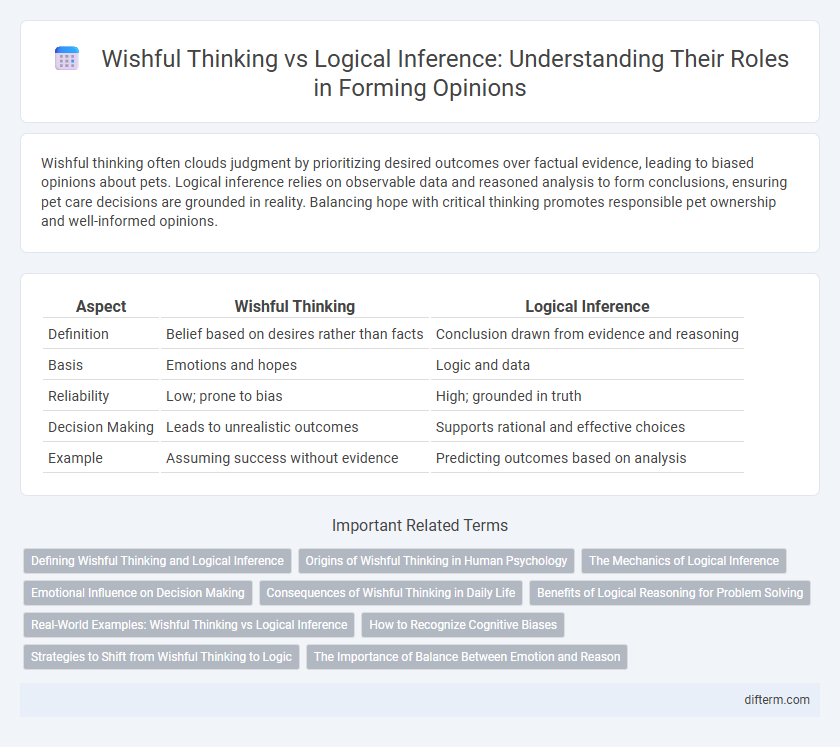Wishful thinking often clouds judgment by prioritizing desired outcomes over factual evidence, leading to biased opinions about pets. Logical inference relies on observable data and reasoned analysis to form conclusions, ensuring pet care decisions are grounded in reality. Balancing hope with critical thinking promotes responsible pet ownership and well-informed opinions.
Table of Comparison
| Aspect | Wishful Thinking | Logical Inference |
|---|---|---|
| Definition | Belief based on desires rather than facts | Conclusion drawn from evidence and reasoning |
| Basis | Emotions and hopes | Logic and data |
| Reliability | Low; prone to bias | High; grounded in truth |
| Decision Making | Leads to unrealistic outcomes | Supports rational and effective choices |
| Example | Assuming success without evidence | Predicting outcomes based on analysis |
Defining Wishful Thinking and Logical Inference
Wishful thinking involves forming beliefs based on what one desires rather than objective evidence, often leading to biased conclusions. Logical inference relies on systematic reasoning and empirical data to draw conclusions that are coherent and justifiable. Understanding the distinction between these cognitive processes is crucial for critical thinking and sound decision-making.
Origins of Wishful Thinking in Human Psychology
Wishful thinking originates from the brain's natural tendency to prioritize desires and positive outcomes over objective reality, often driven by the limbic system's emotional processing centers. This cognitive bias helps reduce anxiety and fosters hope but undermines logical inference by distorting evidence evaluation. Understanding the evolutionary roots of wishful thinking reveals its role in survival, where optimism enhanced motivation and decision-making despite uncertain conditions.
The Mechanics of Logical Inference
The mechanics of logical inference rely on structured reasoning processes such as deduction and induction, which ensure conclusions follow necessarily or probably from premises. Unlike wishful thinking, which often ignores evidence or logical consistency, logical inference emphasizes coherence, validity, and evidence-based justification. This systematic approach is foundational to critical thinking, enhancing decision-making and problem-solving across disciplines.
Emotional Influence on Decision Making
Emotional influence often skews decision making by promoting wishful thinking, which favors optimistic outcomes despite contrary evidence. Logical inference, grounded in reason and factual analysis, mitigates emotional bias and leads to more reliable conclusions. Recognizing emotional triggers enables individuals to balance intuition with critical thinking for better judgment.
Consequences of Wishful Thinking in Daily Life
Wishful thinking often leads to unrealistic expectations, resulting in poor decision-making and missed opportunities in daily life. Relying on hope rather than evidence can cause individuals to ignore warning signs and fail to prepare for potential setbacks. This cognitive bias ultimately undermines personal growth and resilience by fostering denial instead of pragmatic problem-solving.
Benefits of Logical Reasoning for Problem Solving
Logical reasoning enhances problem-solving by enabling clear analysis of facts and evidence, reducing errors caused by wishful thinking. It promotes objective decision-making, ensuring solutions are based on reality rather than hopes or assumptions. This systematic approach improves accuracy and effectiveness in addressing complex challenges.
Real-World Examples: Wishful Thinking vs Logical Inference
Wishful thinking often leads investors to hold onto losing stocks, ignoring market indicators that suggest a decline. Logical inference, grounded in data analysis and trend evaluation, helps analysts predict economic downturns more accurately. Real-world cases such as the 2008 financial crisis highlight how wishful thinking delayed crucial decisions, whereas logical inference prompted timely interventions.
How to Recognize Cognitive Biases
Recognizing cognitive biases requires identifying patterns where wishful thinking distorts reality by favoring desired outcomes over evidence-based conclusions. Logical inference relies on objective analysis and consistent evaluation of information, reducing errors caused by emotional influence or preconceived notions. Awareness of confirmation bias, availability heuristic, and anchoring effect enhances the ability to distinguish between biased judgments and rational decision-making.
Strategies to Shift from Wishful Thinking to Logic
Effective strategies to shift from wishful thinking to logical inference include cultivating critical thinking skills through continuous questioning of assumptions and evaluating evidence objectively. Implementing structured decision-making frameworks, such as cost-benefit analysis and hypothesis testing, helps ground conclusions in empirical data rather than hopeful expectations. Emphasizing cognitive awareness techniques, like recognizing cognitive biases and practicing mindfulness, further supports rational judgment and reduces emotional interference.
The Importance of Balance Between Emotion and Reason
Balancing wishful thinking with logical inference is essential for sound decision-making, as emotions drive motivation while reason grounds choices in reality. Overreliance on hope can lead to unrealistic expectations, whereas excessive logic may stifle creativity and optimism. Integrating emotional insight with analytical thinking fosters well-rounded judgments that adapt to both possibilities and probabilities.
wishful thinking vs logical inference Infographic

 difterm.com
difterm.com